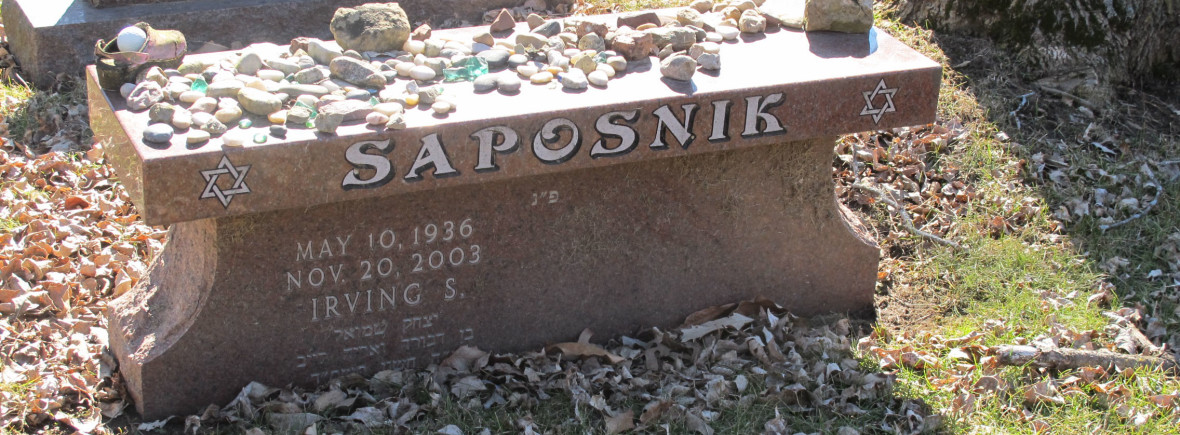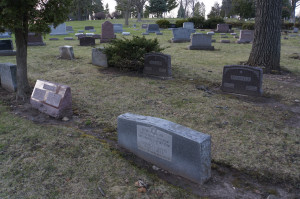As you explore Forest Hill Cemetery, you may notice that most of the Jewish graves at Forest Hill are grouped into one section of the cemetery, identified as the Jewish section, a practice not shared by some of the other religious communities represented at Forest Hill. This tendency toward isolation stems in part from the fact that Jews in Madison represent a small minority community with very different traditions from the surrounding culture. Jonathan Pollack, , a Jewish Studies scholar at UW-Madison, suggests that this insistence on maintaining a separate cemetery has its roots in Jewish folk superstition. Most American Jewish families have European ancestry, and thus inherit the legacy of fear from a historical moment when the persecution of Jews, in the period of pogroms and ghettoization, often led to the desecration of the bodies of the dead, a desecration which, according to superstition, could lead to the soul of the dead returning as a demon or as a dybbuk, literally “a cleavage of an evil spirit,” a malicious ghost-like being with the power to possess the living. While people may not still believe these superstitions, the superstitious fear, and the rituals which stem from them, are carried down throughout generations of Jews who, for example, often will not visit a cemetery on shabat due to these lingering superstitions.

Wisconsin Historical Society, McCabe, Plan of Section No. 10 Forest Hill Cemetery Belonging to the Jewish Congregation, Madison Wisconsin, 105039
This isolation of Jewish graves may also have more recent historical roots, when two or three Jewish merchants might move to a town with no previous Jewish community, would immediately purchase a plot of land in the cemetery to ensure that they would be have a place to rest once they died. This was also a way to cement themselves as a distinct community in these towns, and was thus a particularly common practice in towns with smaller Jewish communities, such as Madison. Normally the Jewish section of the cemetery would be further subdivided, with different plots being purchased by different synagogues, but, because Madison has a comparatively transient Jewish community, with few Jews actually residing here from birth to death, synagogues rarely developed enough of a permanent membership to warrant such a purchase.
You may also notice, however, a number of Jewish graves scattered throughout the cemetery outside the Jewish section. These graves may belong to Jews who married outside the faith, and wanted to be buried with their spouses, who, because they were not Jewish, were not allowed to be buried in the Jewish section. However, non-Jewish graves dating back to the 1870s, a mere two decades after the construction of the cemetery, can be located within the Jewish section at Forest Hill, suggesting that there may be other reasons for the presence of Jewish graves outside the Jewish section. One possible reason may be that many Jews in Madison have historically had other investments stronger than their ties to the Jewish community. Many Jewish graves, for example, can be located in the Masonic section of the cemetery. These Masonic connections often held more social currency than connections to the Jewish community in Madison, as the connections to authorities and clients offered by Masonic lodges often yielded privileges unavailable to those outside the Masons.
Perhaps the most important thing to keep in mind when exploring the Jewish section of Forest Hill Cemetery is that, in Judaism, it is earthly life, and not the afterlife, that is of the highest importance. Eschatological thinking has largely faded not only from Reform Judaism, but also from Conservative and Orthodox forms of Judaism as well, as Jews believe Messianic redemption to be an outmoded concept. The idea of olam haba, a collective future for all of mankind, actually arose during the Rabbinic era, and thus has no root in the Torah itself. This dramatically changes Jewish views of the afterlife, as concepts such as bodily resurrection and eternal reward or punishment (Heaven and Hell) have historically been bound to a messianic eschatology (the rebirth of the Jewish nation in the age of the Messiah) which has largely been rejected by contemporary Jewish cosmologies. These cosmologies instead envision an immortal soul that departs from the body in the moment of death and permanently becomes one with God, a joining which precludes any notion of an embodied afterlife. Because the soul has departed from the body, the body itself does not possess any particular spiritual importance. The actual person resides in the soul, not in the body, which is merely a temporary physical container that the soul occupies for a very short period of its eternal life. It is with God before the person is born, and it returns to God after death.
If there is no bodily resurrection, then why would a cemetery matter at all to the Jewish community of Madison? Professor Jonathan Pollack suggests two potential reasons. Firstly, environmentalism has become an integral aspect of the Jewish belief system, as the idea that people came from dust and will return to dust is cherished by those of the Jewish faith. This actually enables the body to attain a certain form of immortality, as the prayer which leads into the Mourner’s Kaddish indicates: “All flesh is grass, and the goodliness thereof as the flower of the field. The grass withers, the flower fades. The body dies, and is laid in the earth.” The physical matter of the body decomposes and returns to the earth, fostering the growth of new organic life within the cemetery ecosystem, which thus also becomes a monument to the dead. The ubiquity of plant-life around Forest Hill makes it an ideal space for the bodies of the dead to re-enter this cycle of life.
Secondly, the cemetery functions as a place of remembrance. Professor Pollack says that Jews have a history of “making someone immortal through stories,” by recounting anecdotes about the lives of the dead that preserve them as memories within the minds and hearts of the living. The cemetery-space, in which the names of the dead are memorialized, serves as a reminder to continue telling these stories, so that the community will not forget those who have passed. The mourning process is thus more for the mourners than for those who have died. The Kaddish is a public act, an act of mourning shared by the community, to which the congregation responds by coming over and talking to those who have lost loved ones, to remind the living, those left behind, to continue living, and that their community will always be there to look out for them. Shimon M. Glick characterizes the value of human life in Judaism as “infinite,” since “all mankind emerged from a single human being, Adam, and therefore every life has the potential of the entire world” (Glick 120). In other words, Jews do not live ethically because of hope for a celestial afterlife, but in order to make this life here on Earth more enjoyable and meaningful. Lived experiences are valued more highly than one’s experiences after death, and the mourning process serves primarily as a way to ensure that those experiences remain positive. The cemetery allows the dead to share in these experiences, reminding the living of their omnipresence in their lives, both as souls who have joined with God and as memories. Its sacredness derives not from Jewish cosmology per se, but from the personal, familial, and communal acts of remembrance which transpire in that space.
Sources:
Cohn-Sherbok, Dan. The Vision of Judaism. St. Paul, MN: Paragon House, 2004. Print.
Kraemer, David. The Meanings of Death in Rabbinic Judaism. New York: Routledge, 2000. Print.
Raphael, Simcha Paull. Jewish Views of the Afterlife. New York: Rowman & Littlefield Publishers Inc., 2009. Print.
Back to Top | Traditions Main Page | Catholic and Lutheran Traditions | Hmong








